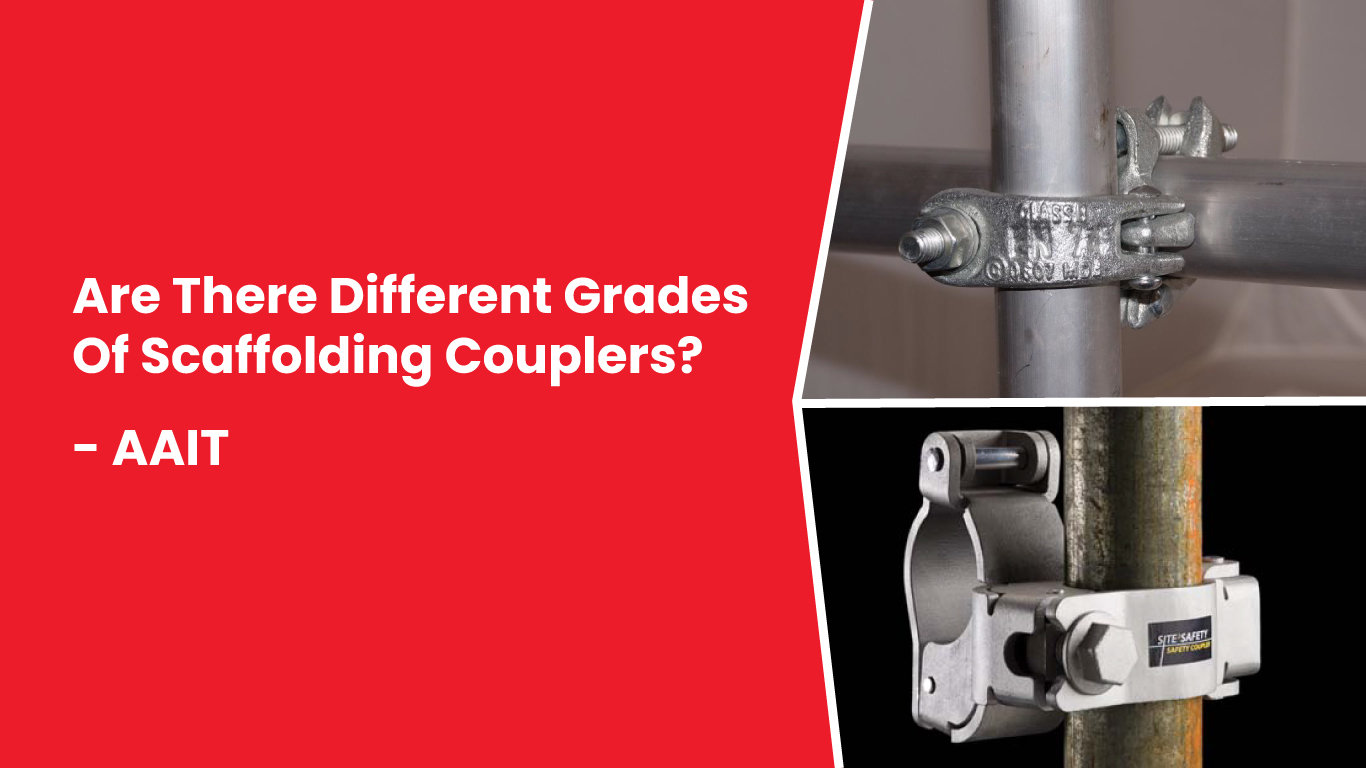
While scaffolding couplers perform an important function in securing the connection between scaffold tubes, not all couplers are created equally. Knowing the different grades of scaffolding couplers can help manage safety, performance and durability of working at a construction site, especially when load capacities and the environment are considered.
What Are Scaffolding Couplers?
Scaffolding couplers are simple connectors that attach scaffolding tubes together. Though small pieces, they serve a very important purpose in guaranteeing the stability and safety of a scaffold structure. They are used to secure horizontal, vertical and diagonal attachments, allowing workers to safely access various levels of structure while performing construction, alteration, or repair. Couplers come in different forms, and each type is designed for specific connections and load requirements.
In any scaffold setup, couplers are responsible for holding everything tightly in place. Without strong and well-fitted couplers, scaffold systems can become weak or collapse under pressure. This is why choosing the right type and quality is so important for construction safety.
Understanding the Concept of Scaffolding Coupler Grade
The word “grade” in this case describes a coupling’s strength, quality and performance standards. It allows for an understanding of how much that coupler will carry in terms of load, what sort of environment it could withstand, and how predictable it is under real-world use conditions. Not all couplers are built the same, and some are made to meet higher standards for industrial or high-risk projects.
Grades of scaffolding couplers are often defined by factors such as the material used, the manufacturing process, and compliance with international safety standards. Higher grades of couplers are used in extreme environments under loads of utmost concern to worker safety, for example, scaffolds of extreme heights and/or heavy-duty support structures, such as performance and construction stages.
Types of Scaffolding Couplers and Their Grades
Scaffolding couplers are divided into several types based on how they connect scaffold tubes. Each type also comes in different grades to match the job requirements.
1. Right-Angle Couplers (Double Couplers)
These are some of the most common couplers used in scaffolding systems. Right-angle couplers are meant to connect two scaffold tubes at a right angle. High-grade angle couplers will be used where stability and load-bearing strength are paramount. Lower grades may be used for smaller or temporary structures.
2. Swivel Couplers
Swivel couplers allow two scaffold tubes to rotate into different angles. Couplers with swivel capability can provide better flexibility for diagonal bracing or unusual situations. Swivel couplers come in different grades as dictated by the thickness, build quality, and loads. The grade has an influence on how well they hold together under movement in which one would expect an angle to be created.
3. Sleeve Couplers
Sleeve couplers join two scaffold tubes end to end, providing a straight-line connection. The grade of a sleeve coupler can determine its ability to maintain alignment and handle axial loads. They are often used where structural alignment is crucial, especially in long runs of scaffold.
4. Putlog Couplers
Putlog couplers are lighter than couplers that connect the scaffold tubes and ledgers and they are not load-bearing fasteners. They are usually not load-bearing fasteners on most non-heavy-duty scaffoldings. Putlog couplers can range in grades but for the most part, lower-grade couplers would be common since they do not support weight.
5. Board Retaining and Girder Couplers
Board-retaining couplers hold scaffold boards in place, while girder couplers connect tubes to beams. These types must be strong enough to resist slipping or shifting. The grades of scaffolding couplers in these types often relate to surface grip, corrosion resistance, and fitting precision.
Materials Used in Different Grades of Couplers
Material plays a huge role in defining the grade of a coupler. Common materials include mild steel, forged steel, and drop-forged alloys. High-grade couplers are often made from hot-dip galvanized steel, which offers added resistance to rust and corrosion. Some also include zinc or chrome coatings to further protect them in wet or outdoor environments.
Lower-grade couplers may use pressed steel, which is more cost-effective but less durable. For long-term projects or extreme weather exposure, high-grade materials offer better performance and safety.
Manufacturing Processes and Their Impact on Grade
The method used to produce a coupler directly impacts its grade. Forged couplers are heated and shaped under pressure, which makes them stronger and more reliable. These are typically higher grade and used in demanding scaffold applications.
Pressed couplers, on the other hand, are made by stamping flat steel sheets. While they are cheaper and lighter, they often fall into lower-grade categories. Manufacturing consistency, quality control, and finishing processes like galvanization also affect the final grade.
Grades of scaffolding couplers are therefore closely tied to how they are built and tested during production.
Load Capacity and Safety Standards by Grade
Scaffolding couplers are tested for load-bearing capacity, and their grades reflect how much weight they can safely support. High-grade couplers must meet international standards like EN 74 or BS 1139. These standards specify torque requirements, pull tests, and material tolerances.
Low-grade couplers may not undergo the same strict testing, which limits where and how they can be used. Using them for tall or load-heavy structures is risky. Always refer to manufacturer guidelines and load charts before making a choice.
Knowing the grades of scaffolding couplers helps ensure you select one that matches your safety needs.
How to Choose the Right Grade for Your Project
Choosing the right coupler grade depends on your project type, height, load, and exposure to weather. For short-term, light-duty tasks, a lower-grade coupler might be sufficient. For high-rise construction, industrial maintenance, or scaffold towers under heavy loads, higher-grade couplers are the safer choice.
Assess the scaffolding plan, understand the forces involved, and consult with a scaffold engineer if needed. A simple error in grade selection can lead to costly and dangerous outcomes. Always buy from trusted suppliers who label and certify their products clearly.
Maintenance and Inspection of Different Grades
Routine inspection is essential for all scaffold couplers, regardless of grade. High-grade couplers can resist wear longer, but they are not immune to rust, impact damage, or thread wear. Check for cracks, deformation, loose fittings, or corrosion before and after each use.
Clean couplers regularly and store them in a dry area. If a coupler shows any sign of weakness, replace it immediately. This is especially important in scaffolding systems where stability is critical.
The better the maintenance, the longer each coupler—no matter the grade—will perform safely.
Safety Measures and Hazard Prevention
Hazard Assessments and Safety Protocols
Before installing scaffolding, perform a full hazard assessment of the site. Check the surface stability, wind exposure, and nearby structures. Select the correct grade of couplers based on these factors.
Use safety protocols such as load testing, tagging systems, and regular checks. Never assume a coupler is safe just because it was last used without issues.
Qualified Scaffold Design
Professional scaffold design includes recommendations for tube size, coupler type, and grades. Follow detailed drawings and avoid on-site improvisation. Always match the design with the correct coupler grade for each joint.
Guardrails, Toeboards, and Fall Protection
Beyond couplers, safety systems like guardrails and toeboards are important. Use them on all open sides and ends of working platforms. Ensure that fall protection gear is used during scaffold assembly and disassembly.
Grades of scaffolding couplers support the foundation, but fall protection safeguards the worker.
Common Mistakes to Avoid
One major mistake is using couplers without confirming their grade. This can lead to failure under load or during bad weather. Another issue is mixing couplers from different grades or manufacturers, which may affect compatibility and strength.
Some users also overtighten bolts, causing damage to the tube or coupler. Others ignore rust or visible damage and continue using the part. Always follow proper installation torque, inspect regularly, and replace any damaged component.
Do not use lower-grade couplers in positions that bear heavy loads or critical structural stress.
Conclusion
Not all scaffolding couplers are created equal. Their performance and reliability depend on their grade, material, and how they are manufactured. Choosing the right grade of coupler is essential to building a safe and long-lasting scaffold system.
Understanding the different grades of scaffolding couplers allows you to make informed decisions for your project. It ensures safety for workers and protects the structure from failure. When in doubt, always select a higher grade or consult a scaffold expert.
FAQ
1. What does scaffolding coupler grade mean?
The grade refers to the strength, quality, and safety performance of a coupler. Higher grades are tested to meet international standards and are used in more demanding projects.
2. Are all scaffolding couplers made from the same material?
No, they vary in material. High-grade couplers are often made from forged steel or galvanized alloys, while lower grades may use pressed steel or lighter materials.
3. How does the grade affect load capacity?
Higher-grade couplers are designed to carry more weight and withstand higher stress. Grade affects how much load a joint can bear safely.
4. Can low-grade couplers be used for heavy scaffolding?
Low-grade couplers should not be used in heavy scaffolding. They are better suited for light-duty applications and temporary setups.
5. How can I identify the grade of a scaffolding coupler?
Grades of scaffolding couplers are often marked on the product itself or provided in the manufacturer’s specifications. Look for certifications, labels, or material details before use.












 Download
Download
Comments are closed